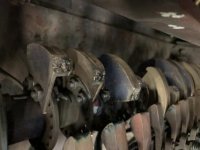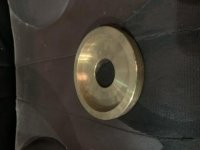Shawn_Laughlin
Aluminum
- Joined
- Mar 28, 2019
We have been putting bandaids on this abused,ragged out set of Bertsch & Co. supposedly 5/8 x 12’ plates rolls since I can remember. It’s old American iron that Had seen much better days. The gear journals that are bent and the gears wobble all over the place when rotating,it’s quite a show.The bushing are so worn out it’s absolutely ridiculous to think this thing can produce a round shell but, I do so until something catastrophic happens it won’t be replaced. So another bandage it is and there is no better place to learn than this website an it’s genius members. Yes I’m kissing ass to get help but it’s not a lie.
I know a little about how 3 phase speed is driving digitally but not so much about the correct series of mechanical links of contact timing in order to not have arc blow and quickly eating away the fingers and rotary contacts when contact is made. Basically if you have three wires ,your 3 phases should they all make contact at one time like a beaker switch or should it be one makes contact and while still in contact the second phase contacts and then while those two are still in contact the 3rd phase can roll around and make its contact without causes arc flashes which are destroying the fingers and rotaries. Pictures below you will see some have no signs of arcing so it would seem the the rotaries are not set up correctly?





I would also really appreciate someone explaining to me how these multiple speed 3 phase reversing barrel switched work?
I know a little about how 3 phase speed is driving digitally but not so much about the correct series of mechanical links of contact timing in order to not have arc blow and quickly eating away the fingers and rotary contacts when contact is made. Basically if you have three wires ,your 3 phases should they all make contact at one time like a beaker switch or should it be one makes contact and while still in contact the second phase contacts and then while those two are still in contact the 3rd phase can roll around and make its contact without causes arc flashes which are destroying the fingers and rotaries. Pictures below you will see some have no signs of arcing so it would seem the the rotaries are not set up correctly?





I would also really appreciate someone explaining to me how these multiple speed 3 phase reversing barrel switched work?


